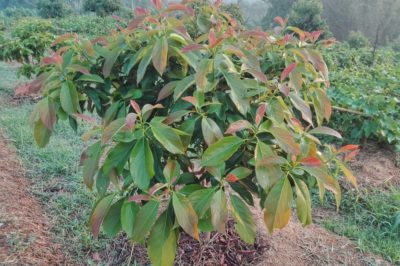Preparing Site and Soil for Planting an Avocado Tree
Plant avocado trees in full sun, and test soil nutrients and pH before planting. Avocados need a pH of 7 or slightly below. To amend the soil, add a 5 gallon bucket of organic compost to the planting hole, mixing it thoroughly with the native soil. This provides the young tree with the nutrients it needs in the first year of growth.
Avocado are native to subtropical areas of the world and can be grow outdoors in USDA climate zones 9 to 11.
Fertilizing Avocado Trees
Avocado trees need nitrogen, phosphorus, potassium, and zinc for growing well. Organic compost, composted manure, and fish emulsion contain balanced amounts of these nutrients. Avocado trees can also be fertilized with citrus tree fertilizers. However, do not fertilize the tree during the first year.
In the second year of growth, fertilize avocado trees with a nitrogen-rich fertilizer in three applications, using a total of ¼ pound of nitrogen. Apply one third of the fertilizer in early March, another third in July, and apply the remainder in October. Do not fertilize after the tree becomes dormant.
In the third year, increase the total nitrogen amount to ½ pound, again applying it in three applications. Continue increasing the nitrogen fertilizer by ¼ pound each year until you reach a total of 1 pound of fertilizer per tree. Then continue at this application rate each year thereafter.
Problems with avocado tree nutrition include:
- Alkaline soil can lead to iron deficiency. Symptoms are new leaves with green veins and yellow between the veins. Amend the soil with a chelated iron supplement according to directions, and mulch with peat moss to improve soil pH.
- Zinc deficiency causes yellow or brown areas in leaves. Amend the soil with organic compost or a seaweed fertilizer, or use a zinc supplement for serious deficiency.
Take action as soon as possible if you notice signs of nutrient deficiency or disease in your trees.
Cultivating Avocado Trees as They Grow
Avocado trees do not like competition for water or nutrients as they grow. Keep grass and weeds 3 feet away from the tree trunk, and mulch the soil around the tree with straw or peat moss for preventing weeds.
Water the tree at least once per week during hot weather. Water more frequently if you notice leaves turning brown or wilting.
Avocado trees have shallow, delicate root systems with most of the roots located in the top 6 inches of soil. Cultivate the soil carefully, so you do not disturb the roots.
